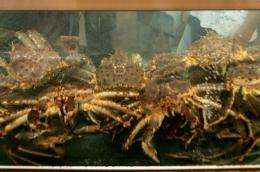Global warming brings crab threat to Antarctica

The sea floor around the West Antarctica peninsula could become invaded by a voracious king crab, which is on the march thanks to global warming, biologists reported on Wednesday.
The worrisome intruder is a bright-red deep-sea predator that previously had been spotted only in the Ross Sea, on the other side of West Antarctica.
Taxonomists identified the crustacean just five years ago, bestowing it with the lengthy monicker of Neolithodes yaldwyni Ahyong and Dawson and placing it among the 121 species of king crab.
It is known as an "ecosystem engineer" because it digs into the sea floor to feast on worms and other tiny animals, an activity that in large numbers can have repercussions across the marine food web.
A team led by Laura Grange of the University of Hawaii at Manoa lowered a remote-controlled scoutcraft as part of a long-term probe into biodiversity in the waters off the Antarctic peninsula.
They looked at Palmer Deep, a mud-floored basin in the Weddell Sea located 120 kilometres (75 miles) from the edge of the continental shelf.
The robot's camera, trailed over two kilometres (1.2 miles), spotted 42 crabs, all of them at depths lower than 850 metres (2,760 feet), where the water was a relatively balmy 1.4 degrees Celsius (34.5 degrees Fahrenheit).
By extrapolation, the crab population in Palmer's deep -- an area measuring 14 kms (nine miles) long by eight kms (five miles) wide -- could be more than 1.5 million, says Grange.
That density is the same as commercial crab fisheries in Alaska and the British South Atlantic island of South Georgia.
The images gave a glimpse of the kind of damage caused by the foraging crustaceans.
The crabs, their shells measuring roughly 10 centimetres (four inches) across, had dug gashes up to 20 cms (one foot) into the soft ocean floor and thrown up lumps of sediment. The robot also retrieved a pregnant female crab, as proof that the species was reproducing.
None of the crabs was found at shallower depths, where the seas are colder.
The implication is that as global warming heats the frigid coastal-shelf waters, which lie at depths of 400 and 600 metres (1,300 and 1,950 feet), the way will be open for the crustacean to continue its creeping advance.
The evidence from sea-floor sediment is that no so-called lithodid, or crushing, crabs have inhabited the cold shallow waters of the West Antarctic peninsula for 14 million years.
Previous research has already named the peninsula as one of the most vulnerable regions in the world for global warming. The waters of its continental shelf are warming at the rate of 0.1 C (0.14 F) per decade.
"If N. yaldwyni is currently limited by cold temperatures, it could spread up onto the shelf within one to two decades," warns the study, published in the British scientific journal Proceedings of the Royal Society B.
(c) 2011 AFP
















